G. I. Madenbaeva , G. S. Matnazarova , E. V. Bryantseva
Department of Epidemiology, Tashkent Medical Academy, Uzbekistan
Copyright © 2023 The Author(s). Published by Scientific & Academic Publishing.
This work is licensed under the Creative Commons Attribution International License (CC BY).
http://creativecommons.org/licenses/by/4.0/

Abstract
Esophageal cancer is the seventh most common cause of death from malignant tumors, is a malignant disease with low survival rates and limited options for treatment in the late stages. The epidemiological situation in developed countries tends to improve. However, in most states the situation remains critical. Among all malignant neoplasms, esophageal cancer ranks first in the Republic of Karakalpakstan.
Keywords:
Esophageal cancer, Incidence, Harmful factors, Rural and urban population, Gender and age of patients
Cite this paper: G. I. Madenbaeva , G. S. Matnazarova , E. V. Bryantseva , Distribution of Esophageal Cancer Among the Population of the Republic of Karakalpakstan in 2021, American Journal of Medicine and Medical Sciences, Vol. 13 No. 10, 2023, pp. 1361-1365. doi: 10.5923/j.ajmms.20231310.01.
1. Relevance
WHO estimates that one in five men and one in six women on the planet will develop cancer at some point in their lives. In 2020, more than 19 million people were diagnosed with cancer [6].The anti-leaders in the number of lives claimed by various cancers are Asian countries - according to WHO, more than 5.8 million deaths in 2020. Europe ranks second with 1.96 million [7].The countries of the Caspian basin (Kazakhstan, Uzbekistan, Iran, Iraq, Turkmenistan, Afghanistan) and a number of other regions of Asia, in which the incidence of esophageal cancer is especially high (the central regions and northern China, Mongolia), are united under the name "Asian cancer belt" [2].The highest incidence of esophageal cancer is observed in the province of Honan (China), where it is 436 per 100 thousand male population and 22.5 per 100 thousand female population. In these areas, cases of esophageal cancer in farm animals have even been described, which indicates the endemic nature of their occurrence. Moreover, when moving to a province with a low level of morbidity, a high level of morbidity was noted, which indicates a long-term retention of inducing factors. Epidemiological studies conducted in provinces with a high level of esophageal cancer revealed several etiological factors, the most significant of which was the high level of nitrosamines in food and water [10].The prevalence of malignant neoplasms in Uzbekistan is 66.7 per 100,000 population, in children - about 10 cases per 100,000 children. One of the large regions of Uzbekistan is the Republic of Karakalpakstan, which has a number of specific climatic, geographical, ethnic, social, and anthropogenic factors [3].Polluted atmospheric air, soil and water serve as a source of contamination of plant and livestock products, which are subsequently used by the population as food.Esophageal cancer is the seventh leading cause of death from malignant tumors in the world, behind cancers of the lung, breast, stomach, liver, prostate and colon. This is due to the extremely malignant nature of the course, early metastasis and late diagnosis of esophageal cancer. The aggressiveness index, calculated as the ratio of deaths to new cases, is extremely high in esophageal cancer and is about 95% [2].Esophageal cancer (EC) is a malignant disease with low survival rates and limited treatment options in the advanced stages. The epidemiological situation in developed countries tends to improve. However, in most states the situation remains critical.
2. Purpose of the Study
To study the dynamics of the incidence of esophageal cancer in the Republic of Karakalpakstan (RK) for 2017-2021, to study the incidence of RK among urban and rural residents, as well as among the female and male population of the Republic of Karakalpakstan.
3. Materials and Methods
We used the official reporting data of the Karakalpak branch of the Republican Cancer and Radiation Center. In the work, operational and retrospective research methods were applied.
4. Results and Discussions
One of the diseases requiring study due to harmful environmental factors in the Republic ofKarakalpakstan are malignant neoplasms with a first diagnosis.As can be seen from this figure (Fig. 1), the largest number of malignant neoplasms in the Republic of Uzbekistan and the Republic of Karakalpakstan was observed in 1991-1994. Moreover, the incidence in the Republic of Karakalpakstan (79.0%) was even slightly higher than in Republic of Uzbekistan (76.2%).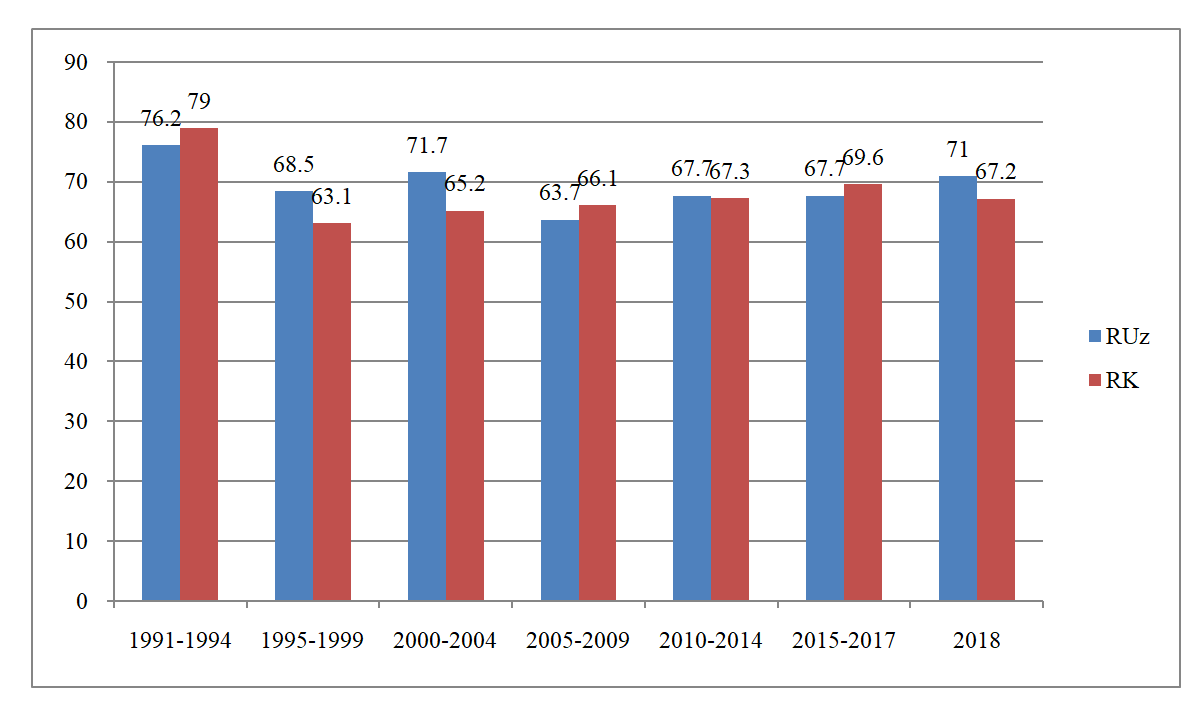 | Figure 1. Dynamics of the incidence of malignant neoplasms in the Republic of Uzbekistan and the Republic of Karakalpakstan (1991 - 2018, int. index) |
Among all malignant neoplasms, esophageal cancer ranks first in the Republic of Karakalpakstan.EC is one of the most aggressive malignant neoplasms. According to the International Agency for Research on Cancer (IARC), in 2018, 572 thousand new cases of EC were registered in the world (3.2% of the total number of malignant neoplasms (MNT)). In 2018, 508.6 thousand deaths from EC were registered in the world (5.3% of the total number of deaths from cancer)The following factors play an undoubted role in the etiology of EC:1. Diet (nitrites, consumption of hot food and drinks, inadequate dietary intake of vitamins and trace elements).2. Tobacco smoking and alcohol consumption are independent risk factors, but in combination with other factors increase the risk of the disease.3. Achalasia of the cardia.4. Burns of the esophagus.5. Autosomal dominant diseases characterized by hyperkeratosis of the palms and feet.6. Human papillomavirus types 16 and 18 cause the risk of developing EC in 37% of patients [1].7. The influence of the external environment, which arose as a result of the Aral Sea ecological catastrophe.According to Kabulov M.K. (1992) carcinogenic substances, such as polycyclic aromatic hydrocarbons (PAH), nitroso compounds, phenols, heavy metals, the content of which was studied in water samples, can play a role in the genesis of esophageal cancer. “Studies have shown that the indicator representative of polycyclic aromatic hydrocarbons (PAHs) - benzapyrene (BP) in all the studied samples was contained in very high concentrations exceeding the MPC (maximum permissible concentrations) from 28 to 90 times. Carcinogenic trace element - arsenic - in high (3 times higher than MPC) quantities was found in the water of the Kyzketken canal, and the content of cadmium in the tap water of the city of Nukus exceeded the MPC by 40 times. In other water samples, the excess of MPC for cadmium ranged from 15 to 30 times. Carcinogenic substances - phenols in the studied water samples were also contained in elevated concentrations exceeding the MPC from 4 to 9 times" [5].A retrospective analysis conducted over 5 years (2017-2021) showed that in 2017 the incidence with a newly diagnosed "esophageal cancer" in the Republic of Karakalpakstan was with an intensive rate of 10.52; in 2018 this figure was 8.14; in 2019 - 6.84; in 2020 - 8.01, and in 2021 the intensive rate of incidence of esophageal cancer was - 8.89 Again, there is a slight increase in the incidence of RP compared with previous years (Fig. 2).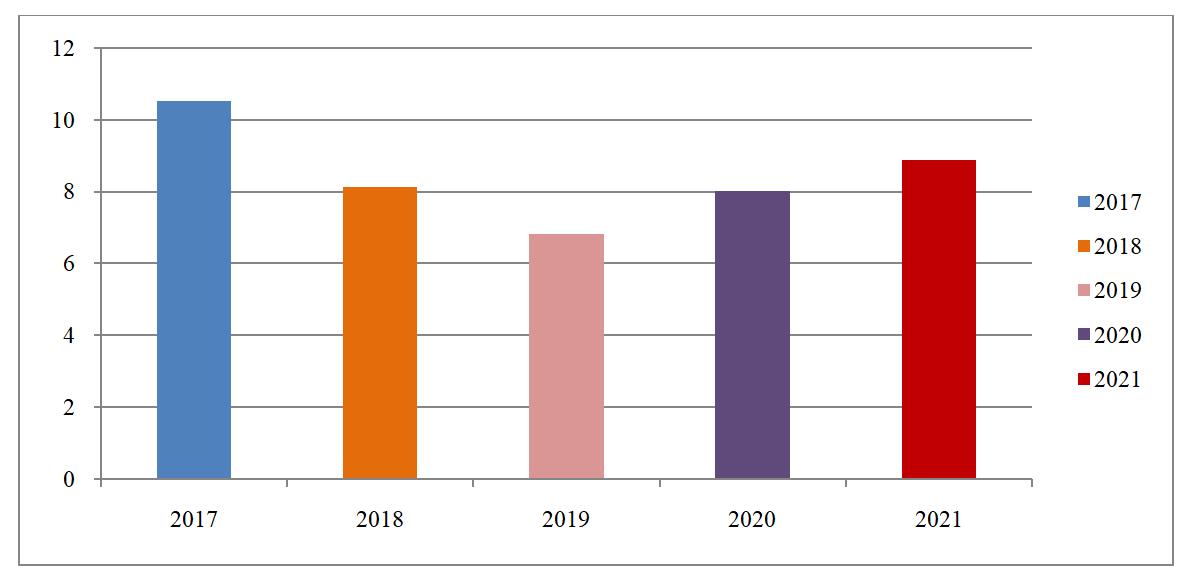 | Figure 2. Dynamics of the incidence of newly diagnosed "esophageal cancer" in the Republic of Karakalpakstan (2017-2021 int. index) |
The incidence of esophageal cancer in the Republic of Karakalpakstan in 2021 was 17.7 per 100,000 population.Of these, the incidence among women in the Republic of Karakalpakstan was with an intensive rate of 13.8, and among men - 3.9 per 100,000 population.When studying the spread of EC among the male and female population, we found that in the Republic of Karakalpakstan, esophageal cancer among women with a newly diagnosed "esophageal cancer" is more common than among men. Thus, in 2021, esophageal cancer was diagnosed in women in 59.40% of cases, and among men - 40.60%, which is 19.0% less. (Fig. 3). For comparison, in the Russian Federation (Pisareva L.F., Odintsova I.N., Ananina O.A. et al. 2014) EC disease is more common in men than in women, among the sick men were 78.7 %, women - 21.3%. Also, the incidence of esophageal cancer is higher in men than in women in South Africa, Mongolia and a number of other countries [8].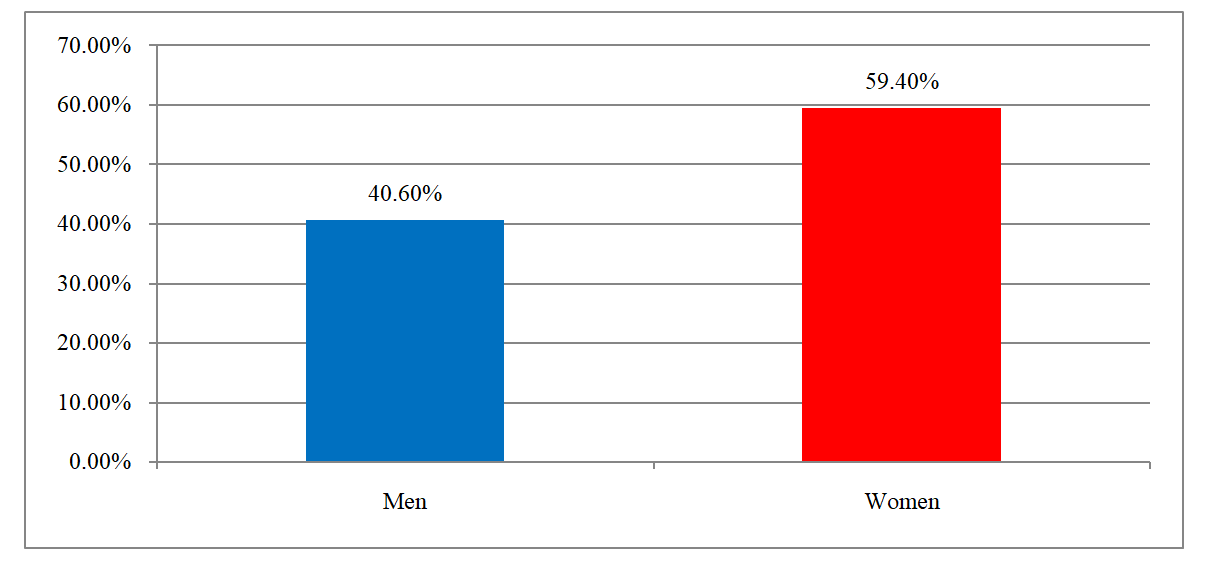 | Figure 3. Distribution of patients by sex with newly diagnosed esophageal cancer in the Republic of Karakalpakstan (percentage in 2021) |
Our data are confirmed by studies conducted in the Muynak region of the Republic of Karakalpakstan (Davydov M.I., Stilidi I.S., 2007), where a high incidence of EC among women was also revealed [4].In our studies, it was found that esophageal cancer in the rural population is much more common than in urban residents.The distribution of patients with esophageal cancer (the calculation was carried out on the basis of data on patients with newly diagnosed EC in 2021) by gender and by place of residence once again confirmed that in rural areas there are more patients (57.1%) diagnosed with esophageal cancer than in urban areas (43.0%), and there are more women who fell ill with this disease both in rural areas and those living in urban areas (rural - women 35.30%, men - 21.80%; city - women 24, 10%, men - 18.80) (Fig. 4).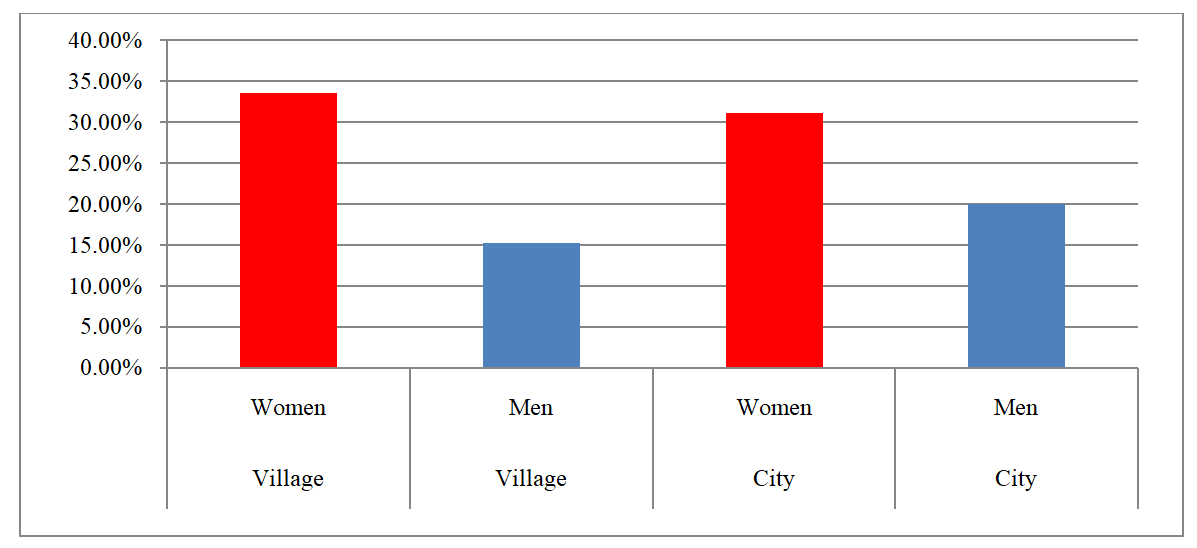 | Figure 4. Distribution of patients with esophageal cancer by sex and place of residence (percentage in rural and urban areas) |
According to WHO estimates, cancer is most often diagnosed after 60 years of age, and the largest group of cases (17.9%) falls on the age of 65-69 years [7].When studying the age composition among patients with esophageal cancer in the Republic of Karakalpakstan, the following results were obtained: high incidence is observed in patients aged 60 to 64 years (35 patients), in second place are patients aged 65 to 69 years (27 people), in third place - from 70 to 74 years old (21 patients), followed by patients over 80 years old (18 people). The smallest number of patients with esophageal cancer was observed among people aged 40-44 years (5), aged 20-24 years, 1 patient was identified. There were no patients with EC in the age groups of 25-29 and 30-34 years old (Fig. 5).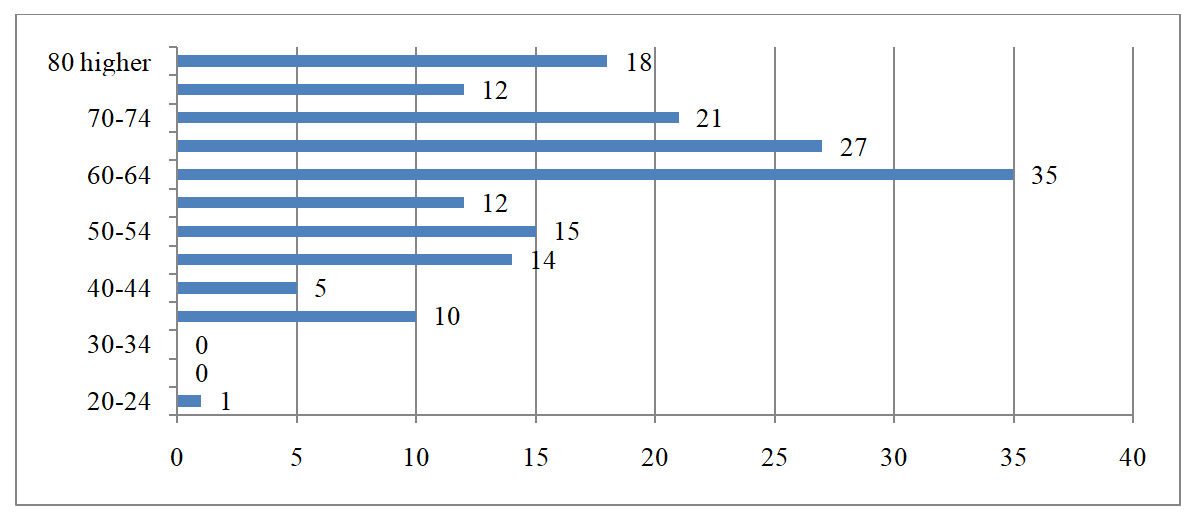 | Figure 5. Distribution of patients with newly diagnosed "esophageal cancer" by age categories (2021) |
The analysis carried out by Kurbanov M.I. (2019) showed that more than 35% of cases of the disease are detected during preventive examinations, so 1/3 of the cases in his studies were detected at stages I and II of the development of the disease.So, for the first time during preventive examinations, 48.2% (82 people) of patients with EC were identified.Of the 170 patients with a newly diagnosed diagnosis, patients with stage I esophageal cancer were detected in 1.8% of cases, with stage II - 29%, the largest number of patients with esophageal cancer was detected at the III clinical stage of the disease and amounted to 42% and from stage IV 27.4% of patients were registered (Fig. 6).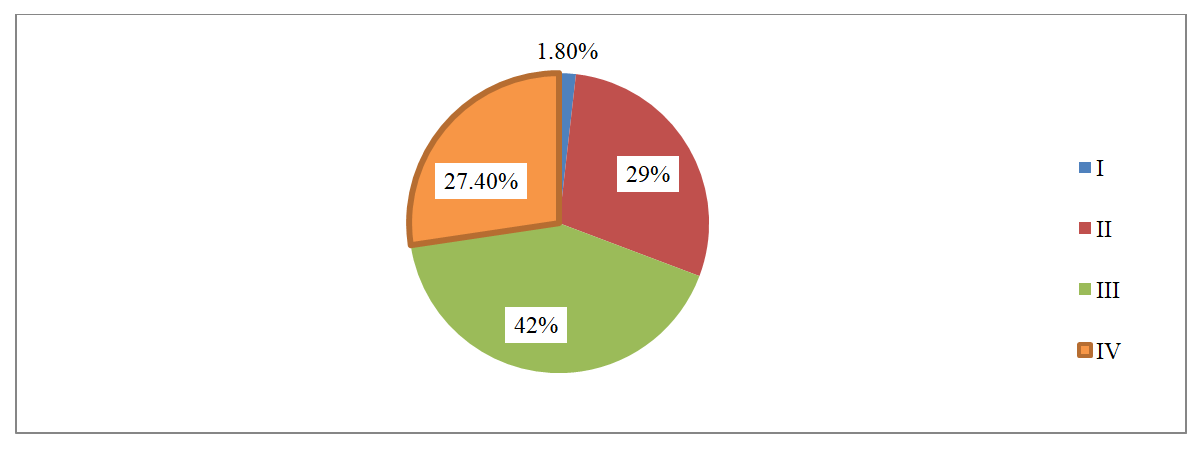 | Figure 6. Distribution of patients by stages with newly diagnosed "esophageal cancer" in the Republic of Karakalpakstan (percentage in 2021) |
Esophageal cancer remains one of the most aggressive malignant neoplasms and mortality from this disease remains high. Thus, the death rate from esophageal cancer in 2021 in the Republic of Karakalpakstan was 6.8 per 100,000 population. Moreover, mortality among women with esophageal cancer is higher than among men; is 4.2 and 2.6, respectively.Until now, all over the world, the choice of a method for treating esophageal cancer remains an urgent problem and depends on the type of tumor, the stage of the disease, and the functional status of the patient. The prognosis for esophageal cancer is considered favorable only in the earliest stages of the disease. “The use of endoscopic technologies provides a minimally invasive approach to the treatment of cancer of the esophageal mucosa and significantly increases the survival of patients. Surgical treatment remains the main method of intervention, however, in locally advanced esophageal cancer, a special approach is required, including a rational combination of radical surgery with chemotherapy and / or radiation therapy. In many countries, preoperative chemotherapy has become the standard of care for stage II-III esophageal cancer. In the later stages of the disease, the main method of treatment is palliative chemo- or chemoradiotherapy” [9].However, the treatment of esophageal cancer is still an urgent problem for modern oncology around the world, it is necessary to develop and implement new methods for the treatment of esophageal cancer.To reduce the mortality of patients from esophageal cancer, it is necessary to establish timely medical examinations, early detection of such patients in the early stages of the disease, as well as treatment with new modern methods.
5. Conclusions
1. in a retrospective analysis of esophageal cancer in the Republic of Karakalpakstan (2017-2021), it was revealed that in 2021 there was a slight increase in the incidence of EC;2. cancer of the esophagus among women (59.4%) is registered more often than among men (40.6%);3. among rural residents (57.1%) in the Republic of Karakalpakstan, esophageal cancer is registered more often than among urban residents (43.0%);4. Mortality among women with esophageal cancer in the Republic of Karakalpakstan is higher than among men; equal to 4.2 and 2.6, respectively, per 100,000 thousand population.
References
| [1] | Davydov M.I., Stilidi I.S. Esophageal carcinoma. M.: Practical medicine, 2007, p. 20–25. |
| [2] | Davydov M.I., Stilidi I.S., Ter-Ovanesov M.D., Polotsky B.E., Esophageal cancer: modern approaches to diagnosis and treatment // Russian Medical Journal-2006; 14: 1006. |
| [3] | Gladilina I.A., Tryakin A.A., Zakhidova F.O., Malikhova O.A., Ivanov S.M., Kravets O.A., Shabanov M.A. Esophageal cancer: epidemiology, risk factors and diagnostic methods // Journal of Oncology: Radiation Diagnostics, Radiation Therapy - 2020, No. 1, Volume 3, p.69-76. |
| [4] | Kaibysheva V.O. Epidemiology, risk factors and prevention of esophageal cancer // Effective pharmacotherapy Gastroenterology" - 2012, No. 6, p.29-34. |
| [5] | Kurbanov M.I. Oncological diseases among the population of the Republic of Karakalpakstan // Proceedings of the I International Forum of Oncology and Radiology. Moscow 23-27 September. 2019, 171 p. |
| [6] | Kabulov M.K. Ways to prevent esophageal cancer in the Republic of Karakalpakstan // Abstract of the dissertation. S - P, 1992. |
| [7] | Pisareva L.F., Odintsova I.N., Ananina O.A., Afanasiev S.G., Volkov M.Yu., Lyakhova N.P. The incidence of esophageal cancer in the Tomsk region. // Siberian journal of oncology. 2014. No. 1 (61) c.33-36. |
| [8] | Urmonov U.B., DobrodeevA.Yu., Afanasiev S.G., Avgustinovich A.V., Cheremisina O.V. Modern aspects of the treatment of esophageal cancer // Siberian Journal of Oncology-2019, No. 4, Volume 18, pp.78-84. |
| [9] | WHO data // https://plus-one.ru/society/2022/02/03/kazhdyy-pyatyy-muzhchina-i-kazhdaya-shestaya-zhenshchina-neizbezhno-zaboleyut-rakom 03.02.2022. |
| [10] | WHO data // https://plus-one.ru/society/2022/07/20/10-glavnyh-prichin-death 20.07.2022. |








 Abstract
Abstract Reference
Reference Full-Text PDF
Full-Text PDF Full-text HTML
Full-text HTML